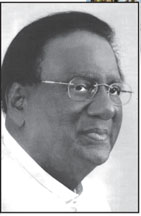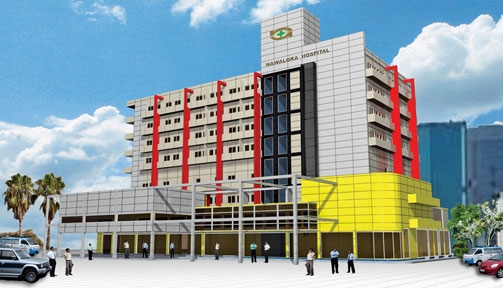Of giant changes, giant buildings and giant men...
by Padma EDIRISINGHE
'Great men involved in philanthropic and very useful work', says Bill
Gates, the king of Microsoft Empire, 'are also human and once in a way
need a pat on the back'.
Slave Island, is one of the disgraceful names in the city of Colombo
or anywhere in the world for that matter.
 |
|
H.K. Dharmadasa |
 |
|
Nawaloka Hospital |
It is where "slaves" were quartered during the Dutch times
(1656-1796) after a household African servant to settle a day time score
crept under the bed of his master and mistress (a Dutch couple) and
killed them both, at dead of night. He was a member of the workforce,
who defying all norms of human dignity were ignominiously "imported"
here from African territories as Madagascar and Mozambique to serve
affluent Dutch families residing in Fort.
After this heinous crime orchestrated by above, all these "Slaves"
working in Fort mansions were deported to this island then separated
from the mainland by a stretches of water connected to the Beira Lake.
Ever since that it has come to be called the Slave Island. Mornings,
they were paddled by boat to the mainland to work in the houses after
answering a roll-call at Kafir Weldt (today the stretch before the World
Trade Centre) and by sunset they had all to get back to the Island. The
boat anchor was just opposite York Street.
However, a peculiar discrepancy was maintained that the locals never
used the term Wahal Doopatha but the translation on the name boards in
public places, both Sinhala and Tamil read Kompanna Vidiya, Street of
companies. No one is sure what these companies were unless one can make
a rough guess that they were Dutch companies going on to become British
companies with change of administration.
Despite the retaining of the despicable English nomenclature the
little Island's landscape has undergone much changes.
It is no more an island, no waterway around it is visible except
where it springs to glimmering patches of water by famous city shrines
as the Gangarama. Geographically there was nothing to distinguish it
from the rest of the sprawling city.
Meanwhile grandiose buildings and exquisite hotels sporting modern
splendour sprang up on it here and there.
With the steady drag of time in the mid 1980s, on the onetime slums
and seedy side of Colombo a frenzy of construction work commenced. At
first no one knew what was going to erupt finally. And then erupt it
did.
Today, according to an information brochure Nawaloka Hospital boasts
a total of 300,000 square feet within the city "thus making it the
largest private sector hospital complex in the country".
The bustle around it as thousands throng is a far cry from the
idyllic picture when Kaffirs sauntered to and fro amidst lush coconut
vegetation.
The hospital also boasts a series of firsts to its credit, first to
introduce CT scanners in 1987, first private hospital to conduct bypass
surgery, the first mammography unit in 1992 and the first MRI Scanner in
1995. etc. The Pain Management Unit drawing patients can be reckoned as
its latest unit.
Over the years the hospital has received various awards that include
the SL National Quality award 1998, Baby Friendly Hospital award from
WHO and UN Children's Fund. It is also the only ISO certified hospital
in Sri Lanka, according to Deputy Chairman, Jayantha Dharmadasa. ,
And who was initially behind this massive venture? It was all
conceived in the mind of one single man. Despite the simple beginnings
from this trader from the South, known popularly as Nawaloka Mudalali,
his vision for the future was extremely vast.
He played the correct note when he realised that the Government
hospitals alone could not cope with the varied health issues of the
country's burgeoning population.
He envisaged the attention to the various units that would
compositely help in grappling the severe problems of health that would
besiege the country in the future. His near and dear were to help him
materialise the gigantic aim.
Ideologists usually with a veering towards Leftist politics never
have a good word for the so called "capitalists".
For they are the ones who go on amassing the all important dough. The
ones who do so, for the mere sake of "amassing" are not forgiven.
But those who use the accumulated wealth not only for their own
advancement about to shoulder the country's welfare should never fall
into the non-forgiven category.
They loom over us in their breadth of vision,in their innate
cleverness in spotting where development is required, in their admirable
determination to go with the venture once started despite all odds,
their sincerity of purpose etc.
Bill Gates, quoted above, the king of the micro-soft empire could be
reckoned as one of the strongest defenders of Capitalism when he coined
the word Creative Capitalism and advocated how those who have amassed
wealth can "Creatively" help ameliorate accumulating problems. Our own
rich men who do not stop at amassing wealth but go on to divert it to
useful purposes can be bracketed with the line of men like Henry Ford
and Rockfeller of USA and PJ Jones of England (Founder of Robinhood
Foundation) and Bill Gates himself who has now gone away from his
Microsoft kingdom to dabble in social welfare work mostly in the African
continent fighting their scourge of diseases as HIV. Gates puts it aptly
when he states, "In these tough times, it is easy to forget that during
the last century the world has got much better but billions have not
been able to benefit from capitalism's miracle. Creative capitalism is
not a big thing. But it is an answer to a vital query which is how we
can most effectively spread the benefits of capitalism for huge
improvements in quality of life.........."
Nawaloka Mudalali's creativity expanded in a novel yet very suitable
and wanting direction. He was really very far-seeing in this respect.
The respective Units that get attached to the hospital gradually are
evidence of the sensitivity he together with his son, H.K. Dharmadasa,
who administers the hospital now, succeeding Dr. Wilfred Wijesinghe,
display towards the health needs of the Sri Lankan populace.
It is also no secret that a good part of the profits of the hospital
are invested in various ways for public health and for public welfare
services. Any human, even well-to-do business need praise and pat of the
back for their good deeds.
As the youth Dharmadasa made his lonely trek from Matara to the
capital along the scenic South Road, some 70 or 80 years ago, it is not
on record that a soothsayer squatting by the way side ever predicted
that,"There goes one who would one day change not only the social and
health arena of the island but the skyline of the Great City of
Colombo".
|

